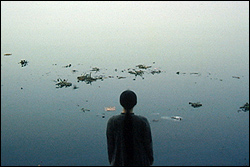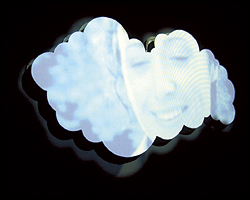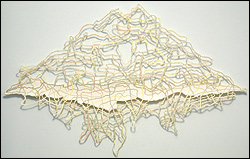It was the day after the election, a cold dark day, and all of us at the Western Bridge press preview—arts writers, an artist, a curator, and assorted gallery people—were in a crappy mood. A certain newspaper art critic arrived wearing sunglasses to hide her teary eyes. Personally, I felt stepped on, almost crushed. All of us gathered at this SoDo gallery that displays William and Ruth True’s amazing collection of contemporary art were looking for an excuse to forget the prospect of four more years of the same old shit.
So maybe I was eager for a little refuge, but still, the show “The Work of the Work”—which is being mounted concurrently at Western Bridge and the Henry Art Gallery—seemed to arrive as the perfect antidote to the poison rage of politics these days.
Henry Art Gallery curator Elizabeth Brown wants to set off epiphanies. I talked to her on two occasions about this show, and it was clear to me that Brown has two ambitious goals behind this sampling of contemporary art. The first is to get to the root of what works in art— we often know or feel it intuitively, and artists talk all the time about finding something that works for them. What is it that sets off that uncanny reaction that good art can evoke?
The second goal, which is entwined with the first, is to create a meaningful experience for the novice art viewer as well as someone more versed in the history and theory of contemporary art. To put it into words: Make it accessible, but don’t dumb it down.
Certainly, we’ve heard a lot of noise lately about various arts institutions— orchestras, theaters, and museums—trying to attract new patrons. And in many ways “The Work of the Work” is a sincere attempt to find art that can speak to a wide audience without the aid of a bunch of curatorial gibberish. The art is displayed with little or no commentary. Frankly, I don’t know if the average American swing voter will go for it, but this long- simmering project of Brown’s has as good a chance as any.
The whole show (you really should try to go to both galleries) has the quiet simplicity of art stripped bare to its essentials. Monochrome paintings. Repetitive or simple videos. Photographs of tangled body parts. White fluorescent lights. In fact, the whole show seems a little narrow—but that’s its strength: It’s a survey with an intense focus, a defining vision. So, in keeping with the spirit of this show, I’ll try not to tell you how to look at “The Work of the Work.” I’ll just bore you with some notes about how it worked on me.
Anne Appleby, Western Cedar: For me, wilderness is mostly an act of memory. I crave the aesthetics of the Cascades high country: meadows blazing purple with lupine, late autumn larches turning an astonishing yellow. But most of my life is necessarily spent in urban existence. Appleby’s multipanel paintings, each a single color, act as remembered traces of nature—fleeting colors of sky, bark, and leaf. She moves abstract painting from the transcendent to the immanent: We are of this world, not merely in it.
Mike Kelly, “More Tragic! More Plangent! More Purple!”: I love the intensity of Mark Rothko’s paintings. But how much of that is tied to the knowledge of Rothko’s suicide? These Warhol-like prints of Rothko’s work make me wonder—what if you could strip the paintings of the biography? Would you still respond?
Candice Breitz, Diorama (Miami Version) Behind Door Number One: A riot of TVs, a living room filled with looped tapes of Dallas. It’s so repetitive and discordant that meaning evaporates from the language. I think: This is what life must sound like to a newborn.
Hannah Villiger, Arbeit: I don’t see much in these photographs of tangled limbs and bodies. Later, I see my own hands contorted at the keyboard. Will work make you free?
Steve McQueen, Girls Tricky: Total darkness. Soon, in the video a figure emerges, chanting, screaming. He’s in a nightclub. No, maybe it’s a coffin. “Never seen your dad, boy,” says the figure in the dark, the trip-hop artist Tricky. A slight claustrophobia. But I’m learning to accept the dark. “Fuck the biological,” says the figure. The trick is getting close enough without catching fire, without burning yourself up.
Olafur Eliasson, Your Compound Eye: A big ol’ kaleidoscope. I wonder what a fly would see, stuck in the Henry Art Gallery?
Kimsooja, A Laundry Woman, Yamuna River, Delhi: As I watch this nearly still video, I remember a scene from Bombay—hundreds of worshippers lining up to enter a mosque on a tiny island off the coast, connected to the shore by a narrow umbilical causeway. Children were playing in the trash washed ashore.
Gary Hill, Tall Ships: A darkened 65-foot corridor. People emerge from the distance as you approach: life-sized videos triggered by motion detectors. They linger until you leave. Coming out of the installation, in the half-light I’m mistaken for someone else. “George, is that you?” a woman says to me. “What’s in there?”
“The Work of the Work” is displayed jointly at Western Bridge, 3412 Fourth Ave. S., 206-838-7444; and Henry Art Gallery, UW campus, 206-543-2280. Runs through Feb. 6.







